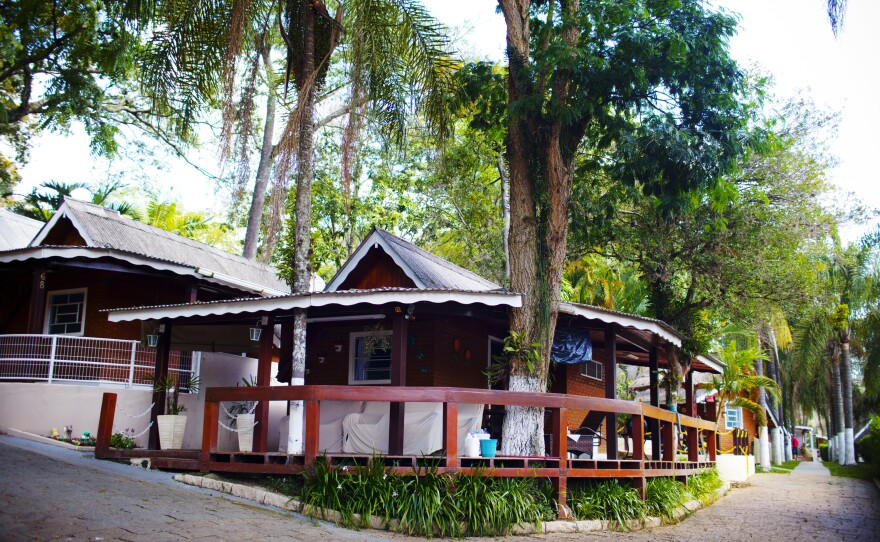





It happened slowly at first. The reservoir's water level dropped, so the resort extended the boat launch ramp.
Then they had to add another extension.
Eventually, the water dropped so much that business dried up — along with the lake.
"For this coming weekend, there's not one reservation. This business was 98 percent dependent on the water. Now that the water's gone, the customers are gone as well," says Francisco Carlos Fonseca, the manager of Marina Confiança.
The resort is located on what were once the banks of one of Sao Paulo's most important reservoir system, called Cantareira. A drought has been devastating the region for the past two years. Unless there is more rain, some water conservation groups estimate there is only enough water to last about five months.
Walking around the resort, Fonseca says that until a year ago, this place was a weekend getaway paradise, packed with vacationers. Today the hotel, with its attached bungalows and party spaces, is a ghost town.
It's a symbol of the economic cost of the drought here.
Fonseca says four or five other marinas have closed completely because there's no access to water. He's not sure what he'll do if his resort closes.
The only thing that could bring tourists back to this region?
"Rain," he says.
This resort was a respite for those living in Sao Paulo. The megacity of 20 million people is as dense with high rises as the Amazon jungle is with trees.
The drought has forced severe water rationing for many of those who live here. Nine million depend on this reservoir system for their daily water use.
The dishes are piled high in the sink when we arrive at Renata Trindade's house in a poor neighborhood in the north part of the city. Since she works during the day, she says she has to be creative about doing chores: She lets dishes and clothes pile up to make sure she and her boyfriend have enough water for other things like bathing or flushing the toilet.
For her and many other Sao Paulo residents, this is the new normal.
And this city is not alone. Brazil's second largest city, Rio de Janeiro, is also facing water troubles, as are other coastal areas. It's been an enormous shock to Brazilians, who are used to their country being called "the Saudi Arabia of Water" — historically, it has had as much water as that Middle Eastern country has oil.
But not anymore. Satellite data from NASA shows that the drought in much of southeast Brazil — also home to the region's breadbasket — is much worse than originally believed. Some recent studies suggest that the lack of rain on Brazil's coasts may be linked to deforestation in the Amazon.
Alexandre Uezu, an ecologist with Sao Paulo's Ecological Research Institute, explains that trees in the Amazon suck up water through their roots and produce huge "flying rivers" of water vapor that move around the continent and fall as rain.
"Were it not because of flying rivers, airflows, the whole area here would be desert," he says. "So we're dependent on the humidity that comes from Amazon."
Except now, according to some estimates, as much as 40 percent of the forest is destroyed or degraded. And that may mean a profound, longterm shift in rainfall patterns here.
So it may take more than a good rainy season to stop Sao Paulo from drying up.
The drought may be exacerbated by other issues, including poor planning. Scientists are trying to determine what is happening and why.
But Uezu can say one thing with certainty: The vast tract of trees in the middle of the continent is crucial to the well-being of people on the coasts, where most Brazilians live.
"Were it not because of the Amazon [forest], we'd have even bigger problems here," he says.
Some people are already deciding to pick up and move their lives completely, in search of more irrigated pastures.
Cesar Farinha Figueredo is what you might call a water refugee. He closed his restaurant in Sao Paulo and moved his family to the city of Jundiai, about two hours away, in the interior of Sao Paulo state.
At his apartment complex, a large pool is full of frolicking sun worshipers. He says moving is the best decision he's made. Back in Sao Paulo, he would spend hours in gridlock, only to get home to find water rationing. It was a struggle to even take a shower.
Here in Jundiai, the city is thriving. Jundiai has water as a result of local government policies that have emphasized conservation and a careful management of their resources. The city's reservoir, full to the brim, is surrounded by thick forest. In a park on its edge, families are playing in the afternoon sun.
That has become extremely attractive to many people in water-starved Sao Paulo. One real estate agent in Jundiai says she has been getting up to 70 calls a day from residents looking to relocate because of the water shortages.
I ask Figueredo if he thinks more people will feel compelled to flee Brazil's economic hub.
Those who can afford it will, he says.
"I already left. The last one to go needs to turn off the lights," he quips.
Copyright 2015 NPR. To see more, visit http://www.npr.org/.






